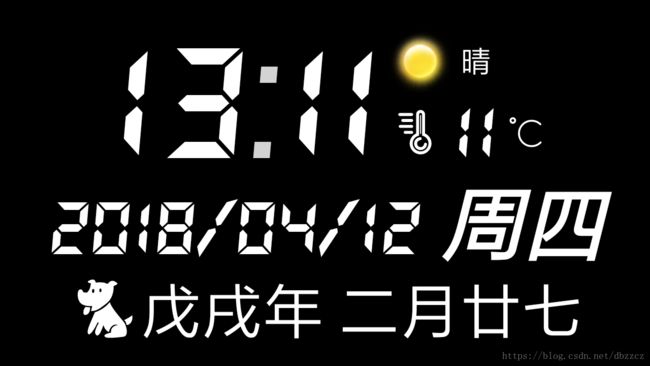Android电子时钟-充分利用您的旧手机
MyClock
一、所使用到的资源及服务
1、实时天气服务
使用心知天气-天气数据API免费接口(其中有收费的服务,这里我用的是免费的接口https://www.seniverse.com/doc)
2、使用retrofit2进行网络请求
3、使用LED字体库(DS-DIGIT.TTF可以网上查询下载)
二、包含功能
1、时间(采用24时形式)、日期(yyyy/MM/dd形式)、周
2、农历计算并自动显示(包括甲子年及生肖)
3、天气(实时天气情况,10分钟更新一次)
二、界面设计
APK采用简单的单页面形式,如下图所示:
三、主界面源码
package cn.daibz.myclock
import android.animation.ObjectAnimator
import android.graphics.Typeface
import android.os.Bundle
import android.os.Handler
import android.support.v7.app.AppCompatActivity
import android.view.View
import android.view.WindowManager
import cn.daibz.bus.helper.net.MyClockService
import cn.daibz.myclock.model.Weather
import cn.daibz.myclock.utils.BrightnessUtils
import cn.daibz.myclock.utils.DateTimeFormatUtils
import cn.daibz.myclock.utils.Lunar
import cn.daibz.myclock.utils.ResourceUtils
import kotlinx.android.synthetic.main.activity_main.*
import rx.Observable
import rx.Observer
import rx.android.schedulers.AndroidSchedulers
import rx.schedulers.Schedulers
import java.util.*
import java.util.concurrent.TimeUnit
/**
* An example full-screen activity that shows and hides the system UI (i.e.
* status bar and navigation/system bar) with user interaction.
*/
class MainActivity : AppCompatActivity() {
private val mHideHandler = Handler()
private val mHidePart2Runnable = Runnable {
// Delayed removal of status and navigation bar
// Note that some of these constants are new as of API 16 (Jelly Bean)
// and API 19 (KitKat). It is safe to use them, as they are inlined
// at compile-time and do nothing on earlier devices.
fullscreen_content.systemUiVisibility =
View.SYSTEM_UI_FLAG_LOW_PROFILE or
View.SYSTEM_UI_FLAG_FULLSCREEN or
View.SYSTEM_UI_FLAG_LAYOUT_STABLE or
View.SYSTEM_UI_FLAG_IMMERSIVE_STICKY or
View.SYSTEM_UI_FLAG_LAYOUT_HIDE_NAVIGATION or
View.SYSTEM_UI_FLAG_HIDE_NAVIGATION
}
private val mShowPart2Runnable = Runnable {
// Delayed display of UI elements
supportActionBar?.show()
fullscreen_content_controls.visibility = View.VISIBLE
}
private var mVisible: Boolean = false
private val mHideRunnable = Runnable { hide() }
/**
* Touch listener to use for in-layout UI controls to delay hiding the
* system UI. This is to prevent the jarring behavior of controls going away
* while interacting with activity UI.
*/
private val mDelayHideTouchListener = View.OnTouchListener { _, _ ->
if (AUTO_HIDE) {
delayedHide(AUTO_HIDE_DELAY_MILLIS)
}
false
}
override fun onCreate(savedInstanceState: Bundle?) {
super.onCreate(savedInstanceState)
setContentView(R.layout.activity_main)
window.addFlags(WindowManager.LayoutParams.FLAG_KEEP_SCREEN_ON)
supportActionBar?.setDisplayHomeAsUpEnabled(true)
mVisible = true
// Set up the user interaction to manually show or hide the system UI.
fullscreen_content.setOnClickListener { toggle() }
// Upon interacting with UI controls, delay any scheduled hide()
// operations to prevent the jarring behavior of controls going away
// while interacting with the UI.
dummy_button.setOnTouchListener(mDelayHideTouchListener)
val tf = Typeface.createFromAsset(assets, "fonts/DS-DIGIT.TTF")
tv_hour.typeface = tf
tv_dot.typeface = tf
tv_minute.typeface = tf
tv_date.typeface = tf
tv_temperature.typeface = tf
val animator = ObjectAnimator.ofFloat(tv_dot, "alpha", 1.0f, 0.1f, 1.0f)
animator.duration = 1000
animator.repeatCount = ObjectAnimator.INFINITE
animator.start()
Observable.interval(0, 1, TimeUnit.SECONDS)
.subscribeOn(Schedulers.newThread()).observeOn(AndroidSchedulers.mainThread())
.subscribe(object : Observer {
override fun onError(e: Throwable?) {
}
override fun onNext(t: Long?) {
val calendar = Calendar.getInstance()
calendar.time = Date()
val lunar = Lunar(calendar)
tv_hour.text = DateTimeFormatUtils.format(calendar.time, "HH")
tv_minute.text = DateTimeFormatUtils.format(calendar.time, "mm")
tv_date.text = String.format(Locale.CHINA, "%s %s", DateTimeFormatUtils.format(calendar.time, "yyyy/MM/dd"),
DateTimeFormatUtils.format2Week(calendar.time))
tv_lunar.setCompoundDrawablesWithIntrinsicBounds(lunar.animalsYearDrawable(), 0, 0, 0)
tv_lunar.text = lunar.toString()
val hour = calendar.get(Calendar.HOUR_OF_DAY)
when (hour) {
in 0..7 -> BrightnessUtils.changeAppBrightness(this@MainActivity, 1)
in 8..9 -> BrightnessUtils.changeAppBrightness(this@MainActivity, 100)
in 10..11 -> BrightnessUtils.changeAppBrightness(this@MainActivity, 120)
in 12..17 -> BrightnessUtils.changeAppBrightness(this@MainActivity, 180)
in 18..20 -> BrightnessUtils.changeAppBrightness(this@MainActivity, 120)
in 21..22 -> BrightnessUtils.changeAppBrightness(this@MainActivity, 100)
in 22..24 -> BrightnessUtils.changeAppBrightness(this@MainActivity, 80)
}
}
override fun onCompleted() {
}
})
Observable.interval(0, 10, TimeUnit.MINUTES)
.subscribeOn(Schedulers.newThread()).observeOn(AndroidSchedulers.mainThread())
.subscribe {
getWeather()
}
}
private fun getWeather() {
val service = MyClockApplication.retrofit.create(MyClockService::class.java)
service.getWeather("shihezi")
.subscribeOn(rx.schedulers.Schedulers.io()).observeOn(AndroidSchedulers.mainThread())
.subscribe(object : Observer {
override fun onError(e: Throwable?) {
}
override fun onNext(w: Weather?) {
if (w != null) {
if (w.results.size != 0) {
val bean = w.results[0]
tv_weather.setCompoundDrawablesWithIntrinsicBounds(
ResourceUtils.getDrawableId(this@MainActivity,
String.format(Locale.CHINA, "weather_%s", bean.now.code)), 0, 0, 0)
tv_weather.text = bean.now.text
tv_temperature.text = bean.now.temperature
println(tv_temperature.text)
}
}
}
override fun onCompleted() {
}
})
}
override fun onPostCreate(savedInstanceState: Bundle?) {
super.onPostCreate(savedInstanceState)
// Trigger the initial hide() shortly after the activity has been
// created, to briefly hint to the user that UI controls
// are available.
delayedHide(100)
}
private fun toggle() {
if (mVisible) {
hide()
} else {
show()
}
}
private fun hide() {
// Hide UI first
supportActionBar?.hide()
fullscreen_content_controls.visibility = View.GONE
mVisible = false
// Schedule a runnable to remove the status and navigation bar after a delay
mHideHandler.removeCallbacks(mShowPart2Runnable)
mHideHandler.postDelayed(mHidePart2Runnable, UI_ANIMATION_DELAY.toLong())
}
private fun show() {
// Show the system bar
fullscreen_content.systemUiVisibility =
View.SYSTEM_UI_FLAG_LAYOUT_FULLSCREEN or
View.SYSTEM_UI_FLAG_LAYOUT_HIDE_NAVIGATION
mVisible = true
// Schedule a runnable to display UI elements after a delay
mHideHandler.removeCallbacks(mHidePart2Runnable)
mHideHandler.postDelayed(mShowPart2Runnable, UI_ANIMATION_DELAY.toLong())
}
/**
* Schedules a call to hide() in [delayMillis], canceling any
* previously scheduled calls.
*/
private fun delayedHide(delayMillis: Int) {
mHideHandler.removeCallbacks(mHideRunnable)
mHideHandler.postDelayed(mHideRunnable, delayMillis.toLong())
}
companion object {
/**
* Whether or not the system UI should be auto-hidden after
* [AUTO_HIDE_DELAY_MILLIS] milliseconds.
*/
private val AUTO_HIDE = true
/**
* If [AUTO_HIDE] is set, the number of milliseconds to wait after
* user interaction before hiding the system UI.
*/
private val AUTO_HIDE_DELAY_MILLIS = 3000
/**
* Some older devices needs a small delay between UI widget updates
* and a change of the status and navigation bar.
*/
private val UI_ANIMATION_DELAY = 300
}
}
